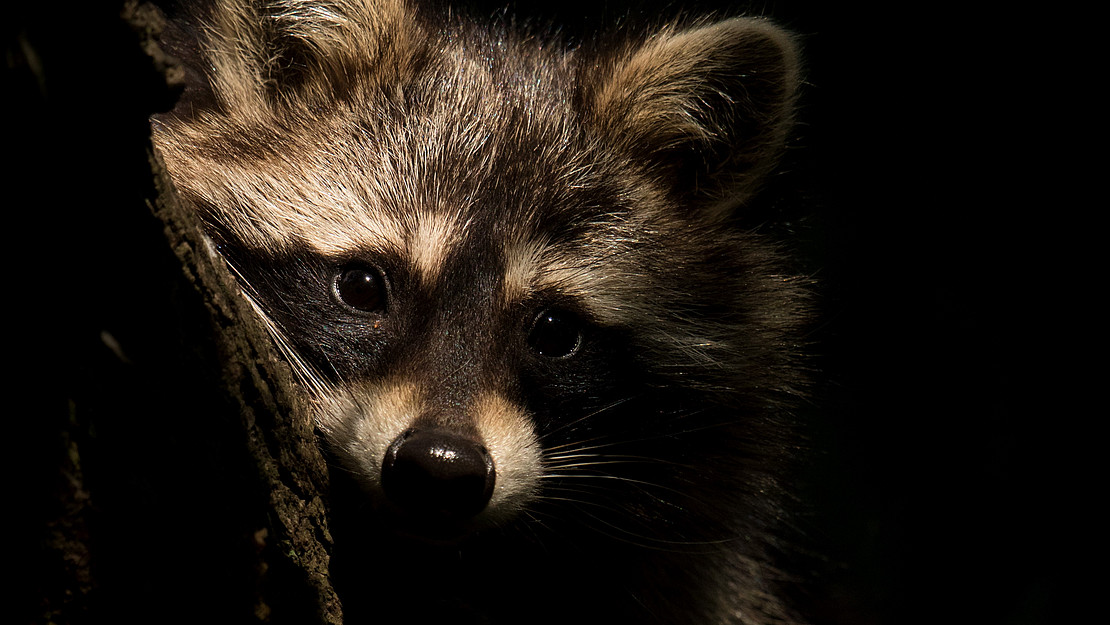This page contains automatically translated content.
"Capital of Raccoons" exhibition from February 2
 Image: Jan Piecha.
Image: Jan Piecha.The photos by Dominik Janoschka and Jan Piecha have already won numerous awards and are being shown in Kassel for the first time in such a comprehensive way. They open up new perspectives on raccoons and their coexistence in human civilization.
Originally native to North America, the wild animals have found their way to the city from Lake Eder, where they were first released in 1934. Thanks to their enormous adaptability, these crepuscular and nocturnal all-rounders are able to colonize different habitats, including urban areas. Here they find excellent living conditions: Human developments provide dry and warm places to sleep and their food supply is enriched by garbage cans, compost heaps and bird feeders.
We share our habitats with raccoons, whether we like it or not. They have found niches and confront us with new challenges. The photos impressively show how the animals live in their self-chosen capital and what it means for the residents of the city.
Photographers Dominik Janoschka and Jan Piecha studied and worked at the University of Kassel and have dedicated themselves to nature photography for many years. "The 'Capital of Raccoons' photo project began for us in 2018 with a single raccoon," says Jan Piecha. "From then on, we studied the species more intensively and scouted out dozens of tree hollows where the animals live. We spent many nights outside taking photos and getting to know their habits." Dominik Janoschka adds: "We followed the animals from their natural environment into the illuminated streets of the city to photograph raccoons in an urban environment. With our photos, we also show the socio-cultural component that arises from the coexistence of wild animals and humans."
Jan Piecha and Dominik Janoschka have already won numerous prizes for their nature photographs. The photos from the project have already won prizes at the European Nature Photographer of the Year, the GDT Nature Photographer of the Year, the Bio Photo Contest, the Comedy Wildlife Photography Award, the Nature TTL Photographer of the Year and the WildArt Photographer of the Year.
With the opening of the photo exhibition, the University of Kassel is continuing its program in the new UNI:lokal in Wilhelmsstraße. "With this open event and exhibition venue in the center of Kassel, we are bringing research and teaching at the University of Kassel into the city and into society," explains President Prof. Dr. Ute Clement. "At UNI:lokal, we want to enter into a dialog with citizens. The topic of raccoons is polarizing in our city and we are looking forward to discussing aspects of our research at the events. We also want UNI:lokal to appeal to school pupils and prospective students, who can find out about the wide range of courses on offer at the university."
At the opening of the exhibition on February 2 from 4 p.m., Dr. Annette Voigt will give a talk on "Raccoons, urban foxes and pigeons: experiences of humans and animals living together in the city and innovative ideas for the future".
She asks how we want to live with wild animals in the city. The city has become a space where people and animals meet and interact, but it is also regulated by city administrations through the protection, relocation or killing of animals. For socio-ecological transformation and a diverse nature in the city, it would be necessary to relativize human interests of use and ideas of order. What would be the prerequisites for the coexistence of humans and animals in the city?
Dr. Annette Voigt is a research associate in the Department of Open Space Planning at the University of Kassel and is researching the interaction between wild animals living in urban spaces on the one hand and the political, planning and administrative actions that respond to this animal presence on the other in the DFG project "Planning of animal-human relations in the 'urban habitat'".
Dominik Janoschka and Jan Piecha will then present their photo project. They will talk about their nocturnal photo tours and how they can now track down one of our secret fellow citizens at any time of day or night. Visitors are invited to talk to the curators.
Capital of the raccoons
A photo exhibition by Dominik Janoschka and Jan Piecha
February 2 to March 22, 2024
UNI:Lokal, Wilhelmsstraße 21, Kassel
Opening hours:
Tuesday to Friday: 12:00 to 17:00
Saturday 11.00 to 15.00
Closed on Mondays
Admission free
Further information and all accompanying events: www.uni-kassel.de
Would you like to visit the exhibition with a school class?
Please contact us at uni-lokal[at]uni-kassel[dot]de
Accompanying program
February 22, 6 pm:
Picture lecture by Jan Piecha: "In search of your own pictorial style" + curator's tour
What actually makes a good picture? What should it look like? Sharp? Colorful? Creative? Abstract? Over the years, Jan Piecha has acquired various photographic techniques and offers an insight behind the scenes of his photographic works.
March 12, 6 pm:
Picture lecture by Jan Piecha: "Walks through Kassel's urban nature" + curator's tour.
Although the photo project about the raccoons has been his main focus in recent years, Jan Piecha has been able to capture many other motifs with his camera during this time. In his lecture, he shows what else there is to discover "on our doorstep".
Always UNI:Lokal, Wilhelmsstraße 21, Kassel